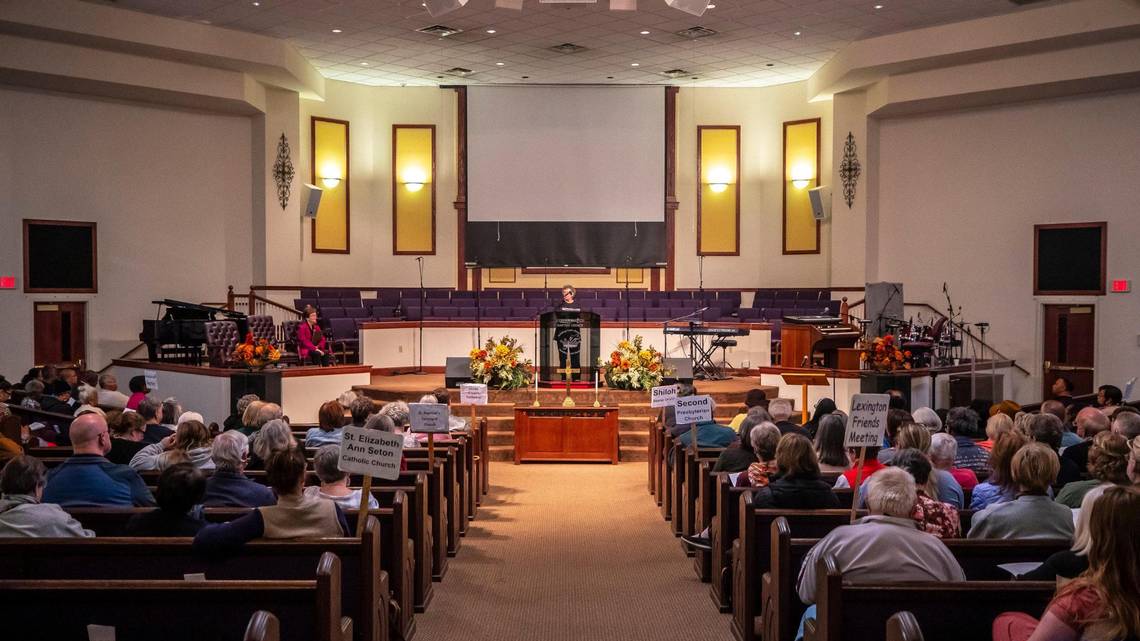By Karla Ward, Lexington Herald Leader
Lisa Webb was sitting in a Lexington medical office, waiting on a bus. She had an appointment to have lab work done at 8:50 a.m., but she said the bus, operated by a nonprofit agency that provides rides to people with Medicaid, didn’t drop her off until after 9 a.m. She was late. By 9:20 a.m., she was finished with her appointment, but the bus was gone, and she had no idea how long she might have to wait for a return ride home.
“I have sat sometimes for hours,” which can be difficult because she has sciatic nerve pain, Webb said in a telephone interview while she waited. At least she made it there. Webb said she and her 3-year-old grandson, who has a serious medical condition, have missed multiple appointments because she just didn’t have a ride. Sometimes, she said her grandson might go in for an appointment on a Monday, and the staff would like them to come back for a recheck Wednesday. That doesn’t work, she said, because the transportation provider requires more notice than that to book a ride.
Webb lives on a fixed income, and she said a car is not within her budget. Ride sharing services like Uber and Lyft, she said, are also beyond her ability to afford.
So she relies on public transportation and other people to get her where she needs to go.
Once, when her grandson was in the hospital for a few months, she said she “spent over $300 that I did not have at all,” on rides going back and forth from her apartment to the hospital.
“It’s horrible,” she said.
Many Lexingtonians are in the same boat, said Kabby Akers, who has been working on the problem of transportation with the organization BUILD, which stands for Building a United Interfaith Lexington through Direct-Action. It’s a coalition of 26 church congregations.
BUILD was a catalyst for the city’s affordable housing fund. For the past two years, the organization and its 26 congregations have turned their attention to transportation, in hopes of getting Lextran to pilot a microtransit program.
‘AN UPHILL BATTLE EVERY TIME THEY LEAVE THEIR HOME’
At a recent Community Problems Assembly hosted by BUILD, Akers said public transportation in Lexington often “falls short,” leaving people “trapped in transit deserts” and facing “an uphill battle every time they leave their home.”
“These gaps will only get worse as our city continues to expand,” Akers told the crowd gathered at Consolidated Baptist Church that night. “There are limitations to what our bus system can provide.”
The organization learned about the transportation problems while researching barriers to mental health services, said Gail Swanson, who serves on BUILD’s Transportation Steering Committee.
Representatives of New Vista, which provides mental health and substance abuse treatment, told BUILD that lack of reliable transportation is the primary problem keeping their clients from accessing services.
“People couldn’t get to their treatment,” Swanson said.
But she said BUILD representatives soon learned the problem extends far beyond people facing mental illness to many others for whom existing transportation services aren’t working for various reasons.
Sometimes, people need to get to jobs during hours city buses aren’t running, or they may need to go places far from a bus stop.
“We heard stories about the refugee population,” Swanson said. “We heard stories about seniors who just wanted to go visit a friend.”
In an ironic twist, she said one woman who wanted to attend the Community Problems Assembly had planned to ride the Wheels bus to the event, but “Wheels didn’t come get her.”
Swanson said it’s a familiar refrain: “You have to be prepared not to get to go.”
FILLING IN THE GAPS
Microtransit programs like the one BUILD advocates for generally seek to supplement public transportation by providing rides on demand at a price similar to a bus fare.
Proponents say it offers flexibility that a bus system with fixed routes can’t provide.
“I think it’s a great opportunity for this community to work with Lextran to kind of fill in the gaps where we have some issues,” said Lexington-Fayette Urban County Councilmember Chuck Ellinger.
Ellinger, who has been working with BUILD on the issue, said Lexington’s bus system does “a great job” with getting people moved around the city on its major corridors, but outside those areas, he said, “there’s some gaps.”
At the request of BUILD, Ellinger hosted a Community Transportation Summit in October where a representative of Via, a company that provides microtransit services, gave a presentation on how microtransit works.
A Lextran representative and several council members were among dozens who attended.
Via’s representative, Sarish Kasat, told those in attendance the system would operate similar to an Uber or Lyft, with riders using a mobile app, website or phone number to book a ride when they need it. Wait times are typically about 10 to 25 minutes, he said.
But unlike Uber or Lyft, riders might not have the vehicle all to themselves, as the driver might make short detours along the way to drop off or pick up other passengers. Software puts trips together to maximize efficiency.
And unlike the city’s Wheels system, which serves people with disabilities, microtransit could be used by anyone.
Other cities, Ellinger and others said, have used the system with success.
Birmingham, Alabama, for example, launched its Birmingham On-Demand service, which is partnered with Via, in 2019. It has continued to expand since then.
But such systems are not without limitations, and they wouldn’t solve every transportation conundrum.
Though microtransit vehicles don’t run on fixed routes, they do operate within fixed zones within a city, so each trip must begin and end within a given zone.
Kasat told attendees at the transportation summit that people who are too far from a bus stop sometimes use microtransit to ride to a stop, then take a bus to their final destination.
But such systems are not without limitations, and they wouldn’t solve every transportation conundrum. Though microtransit vehicles don’t run on fixed routes, they do operate within fixed zones within a city, so each trip must begin and end within a given zone. Kasat told attendees at the transportation summit that people who are too far from a bus stop sometimes use microtransit to ride to a stop, then take a bus to their final destination.
And depending on how the program is designed, riders may be dropped off and picked up at nearby intersections, or “virtual bus stops,” though programs may offer “door-to-door” service depending on the physical ability of the rider, Kasat said.
“Accessibility is a big piece of microtransit,” he said in his presentation.
LEXTRAN’S ROLE
Ultimately, the decision of whether to proceed with a microtransit program would likely fall to Lextran.
Microtransit is not a new idea to Lexington’s public transit agency.
Lextran included a feasibility analysis for “mobility on demand” in the Comprehensive Operations Analysis report it published last year, looking at how such a service might look in Lexington, potential zones where it might operate and how much it might cost.
Fred Combs, Lextran’s director of planning, technology and community relations, said the topic has been “kind of big in the industry the last few years,” and BUILD’s prodding has helped launch a conversation about it in Lexington.
He said the agency is “not opposed” to the idea of microtransit.
“We’ve been thinking about it on our side,” he said. “There’s some potential in some parts of the city where this could be successful. …We just want people to be able to move.”
He said the next step would be to refine “what the service is going to look like.”
How to fund such a program is a big question that remains unanswered too.
“It’s not something that we have budgeted,” Combs said. “It’s not going to be inexpensive. I don’t think Lextran could do it alone.”
Ellinger said it’s estimated that a year-long microtransit pilot program could cost in the range of $500,000 to $1.5 million.
He said the program could be funded through grants, or money from the city budget if there’s a surplus.
Ellinger has brought the issue to the urban county council for input, and said he senses “the council is very willing to consider options because there’s a need here.”
“It’s all about the money,” Ellinger said.
SEEKING PUBLIC INPUT
So, what’s next?
On April 30, BUILD will host its Nehemiah Action Assembly at the Central Bank Center, an annual event where the organization draws a crowd from its member congregations and brings local officials up on stage to ask for specific commitments from them.
“We need broad community support,” Akers told BUILD supporters at the Community Problems Assembly. “It will take a lot of people power to get Lextran to come to the action and say yes.”
Combs said the public needs to “engage with this if you’re interested in it.”
“We need to know who’s going to be using it,” he said. “If it doesn’t work for you, it’s not going to work at all. Engage with us.”
He said people can email their thoughts and concerns to info@lextran.com.
View the original story here.






